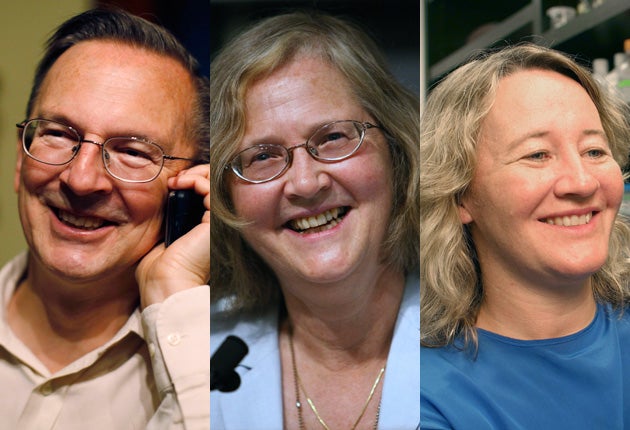Trio's cell study earns Nobel medicine prize

Three scientists have shared this year’s Nobel prize in medicine for their pioneering work in understanding how chomosomes – the microscopic filaments containing the cell’s genetic material – are able to divide repeatedly without falling apart.
They discovered how vital structures called telomeres at the tips of the chromosomes allow the cell’s long molecules of DNA to replicate without getting progressively shorter. They also found how telomeres are able to replenish themselves and so prevent premature ageing of the cell.
The work has revolutionised the fields of cancer research and the study of tissue ageing. It is now realised that telomeres, and the enzyme telomerase that helps to make them grow again after being shortened in each cell division, are central to whether a cell stops dividing and dies, or whether it continues to divide in perpetuity by forming a cancerous tumour.
All three scientists are American citizens and work in the United States. Australian-born Elizabeth Blackburn, British-born Jack Szostak and US-born Carol Greider each share a third of the 10 million Swedish crowns (£900,000) prize money awarded by the Nobel Assembly at the Karolinska Institute in Stockholm for the 2009 Nobel Prize in Physiology or Medicine.
“The discoveries by Blackburn, Greider and Szostak have added a new dimension to our understanding of the cell, shed light on disease mechanisms and stimulated the development of potential new therapies,” the Karolinksa Institute said in a statement issued today.
Professor Greider, 48, of Johns Hopkins University in Baltimore, the youngest of the three and a former graduate student of Professor Blackburn’s, said that the early work she carried out with her colleagues in the 1980s was driven by scientific curiousity rather than a practical use.
“We had no idea when we started this work that telomerase would be involved in cancer, but were simply curious about how chomosomes stayed intact. Our approach shows that while you can do research that tries to answer specific questions about a disease, you can also follow your nose,” Professor Greider.
Telomeres have been likened to the plastic tips of bootlaces that stop them from fraying. They bind to the end of the chromosomes, preventing them from fragmenting each time the chromosome divides in two during cell division.
Professor Blackburn of the University of California San Francisco and Professor Szostak of Harvard Medical School, showed that specific sequences of DNA building blocks within the telomeres of one species of microbe can be placed on the ends of artificial chromosomes and protect them from disintegrating when inserted into the cells of a completely unrelated species.
“This demonstrates the existence of a previously unrecognised fundamental mechanism. Later on, it became evident that telemore DNA with its characteristic sequence is present in most plants and animals, from amoeba to man,” the Karolinska said.
Further research showed mutations that shortened the telomeres led to cell senescence, when they grow old and die, whereas the enzyme telomerase, which lengthens the telomeres, keeps cell actively dividing, just like a cancer cell. Drug companies are now invesigating telomerase for anti-ageing and anti-cancer properties.
Join our commenting forum
Join thought-provoking conversations, follow other Independent readers and see their replies
Comments